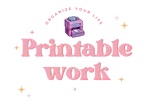Ever feel like you’re juggling too many tasks and forgetting the most important ones? You’re not alone?and there’s a simple solution that works: the checklist.
A well-structured checklist helps you stay on top of daily tasks, improve mental clarity, and enhance time management. But beyond just writing things down, there?s real science behind the effectiveness of checklists.
In this post, we explore the checklist benefits for productivity, why they work, and how you can use them in your daily routine to become more focused and efficient.
? 1. Clarity and Focus
One of the main checklist benefits for productivity is clarity. When everything is written down, your brain doesn’t have to hold it all. This frees up cognitive resources, allowing you to focus on doing rather than remembering.
Instead of scanning your mental to-do list, a physical or digital checklist helps you stay focused on the next step. This is especially helpful when you’re multitasking or prone to distractions.
? 2. Motivation Through Small Wins
Each time you tick off a task, your brain gets a little dopamine boost. This feel-good chemical motivates you to keep going. That?s why checklists are so satisfying?they make your progress visible.
This concept, known as “completion bias,” explains why simple lists can make us feel more productive. By reinforcing a sense of achievement, they help build momentum.
? 3. Reduced Stress and Overwhelm
Feeling overwhelmed by everything you need to do? Checklists reduce stress by making the invisible visible. Tasks become manageable when broken into steps.
In fact, many productivity experts recommend using checklists for this very reason. It?s one of the most powerful ways to reduce decision fatigue and stay in control.
? 4. Consistency and Routine Building
Checklists help create consistent habits, especially for repetitive tasks like morning routines, work check-ins, or school prep.
This makes them a perfect tool not just for professionals, but also for families, students, and anyone managing multiple responsibilities.
Printable checklists, especially those with visual structure, are widely used by parents and educators to build routines at home or in the classroom.
? 5. Accountability and Self-Tracking
A checklist makes your goals visible and measurable. Whether it’s a personal goal like exercising three times a week or a professional goal like completing a project, writing it down increases follow-through.
Many people use daily or weekly checklists to review their performance and spot productivity patterns. It?s a simple but powerful habit that leads to better time management and accountability.
? Why Checklists Work: The Science
Studies have shown that checklists improve memory recall, task accuracy, and reduce mistakes, especially in high-stakes environments like hospitals and aviation. If they work for surgeons and pilots, they can certainly work for you!
The science supports what many already practice: using checklists improves task execution by reducing cognitive load and increasing structure.
? Printable Checklists to Get Started
Ready to put it into practice? We’ve designed a collection of printable checklists to help you stay on track.
They include:
- ? Daily productivity planners
- ? Task-specific checklists (like cleaning, self-care, study habits)
- ? Editable templates for personal or family use
? Explore Printable Checklists at PrintableWork for Kids
? Explore Printable Checklists at PrintableWork for Adults
These tools are perfect for those who want to simplify their lives and be more intentional with their time.
? External Resource:
For in-depth insights on why checklists remain essential tools, this Harvard Business Review article explains why we continue to rely on?and love?our to-do lists:
? Why We Continue to Rely on (and Love) To?Do Lists ? HBR
? Final Thought
Whether you’re a busy parent, a student, or a professional, the checklist benefits for productivity are undeniable. They help you manage time better, feel more accomplished, and reduce the chaos of daily life.
Start small. Stay consistent. And let the checklist think?so you can focus on the doing.







